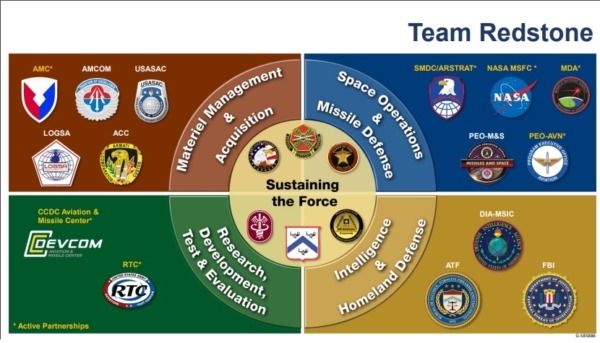Huntsville-Madison County Chamber’s Redstone Update Provides a Glimpse Behind the Gates
In his discussion of the FBI coming to Huntsville, Federal Bureau of Investigation (FBI) Finance and Facilities Division Acting Assistant Director/CFO Nicholas Dimos reported that its move to Redstone is the largest single investment in the institution in its history. “It’s really the future of the FBI and it’s all about technology, innovation, talent, and resiliency.”
Currently, 1,218 individuals work for the FBI in its Huntsville location, with 2,000 additional personnel coming to Huntsville by summer 2022. That number will increase to 5,200 by 2028, with an additional 2,500 training seat capacity.
The FBI will have a North and South Campus on the Arsenal property. Five key North Campus facilities opened this year on base, with several others currently under construction.
The South Campus Academic Zone and Smart City is on track to break ground next year and will be operational by 2025. Dimos described the facility as having a walkable, campus-like feel with a sense of community.
Dimos stated that there are four key strategic objectives set by FBI Director Chris Wray that apply to Huntsville specifically: developing a Counter-IED Center of Excellence, strategic realignment that will transition a large portion of the DC workforce to Huntsville, enterprise and applied technology addressing emerging threats, and advanced and specialized training providing knowledge, skills, and talent for 21st century challenges.
The FBI is actively hiring data analysts, computer scientists, forensic examiners, cybersecurity analysts, and network engineers. Dimos stated that although they are working with local educational institutions, they are also seeking people to come to Huntsville from elsewhere. He added that the FBI has two dedicated recruitment platforms: FBIJobs.gov/Huntsville, and FBI Jobs on LinkedIn.
The selection of Huntsville as its new location is already paying off for the FBI’s recruiting efforts. Dimos said that there were positions they could not fill in the DC area, but as soon as they posted those openings in Huntsville “the inboxes filled up.”
Lt. Gen. L. Neil Thurgood of the Rapid Capabilities and Critical Technologies Office (RCCTO) stressed the uniqueness of his organization and the importance of its industry partners. His organization works at “a pace we haven’t seen since 1950…we are behaving differently than we ever have.” Thurmond credits transparency and open communication with its speed.
Thurgood said his organization is set up differently from any other Army organization. Because the RCCTO is organized like a venture capital organization, it has the ability to create short-term teams to develop rapid prototypes for warfighter capabilities.
Thurgood discussed a few of the projects the RCCTO is working on, including the “Dark Eagle” Long Range Hypersonic Weapon (LRHW) and the Valkyrie 300kW-class laser system. He added that “this valley, for our nation, is the heart of hypersonics for the nation.”
Another thing the RCCTO does to set itself apart from other Army organizations is its solicitation of technology ideas from industry and academia. Its Army Strategic Rapid Acquisition (AStRA) program allows companies to submit concepts and proposals: “If you have a good idea, we want to know about it.”
Projects developed through this program include a Bradley hybrid electric vehicle, a spherical brake system modeled after those of race cars, and an Enhanced Vehicle Security System (EVSS).
During the Redstone Synergies Panel discussion, panel members Tom Webber, Don Nitti, Col. Steven Ansley, and Kim King focused on the synergistic aspect of their respective agencies on the Arsenal and their agencies’ roles in protecting the safety of the nation. Each of the speakers stressed the importance of cutting-edge technologies in the implementation of their missions, as well as the cooperation between the agencies and the importance of the local community in helping them to achieve their goals.
Lt. Gen. Donnie Walker wrapped up the Redstone Update by providing an overview of Redstone Arsenal’s importance to the Tennessee Valley, highlighting its exciting work and the global impact of the Army Materiel Command, as well as the economic impact of the Arsenal on Huntsville and the Tennessee Valley.
Redstone Arsenal has a total annual economic impact of $18 billion, equivalent to 9,8 percent of the Alabama state GDP. In addition, it generates approximately 109,000 jobs, including 44,500 direct jobs on Redstone Arsenal, along with 64,500 indirect jobs across the region.
Major career fields supporting Redstone include science and engineering, logistics management, and acquisition and contracting. The Arsenal produces around $467 million in total state and local tax revenue and provides approximately $5.9 million in contracts to the state of Alabama.
Lt. Gen. Walker also discussed future developments underway, including the Redstone Gateway development, its focus on minimizing the Arsenal’s impact on the environment, and a new partnership with Huntsville Utilities for water, electricity, and gas.
Walker stressed Redstone’s dedication to improving the quality of life for Arsenal employees, including access to affordable housing and higher education. He pointed out that unlike other locations, the Arsenal continued its morale activities throughout the pandemic despite financial losses incurred. Redstone Arsenal also issued almost 2,000 recreation badges to local residents in 2021, enabling the general public to hike and fish on base.
Walker echoed the sentiments of all of the speakers, saying “Everything we do is about people…our people demonstrate the best qualities in this nation: dedication, commitment, patriotism, pride in what they do, and a selfless service to the greater good. They give their time and energy and their brain power to every mission they face. Our people really are our greatest strength and the reason we can envision the bright future that’s both here and now and that’s ahead.”













